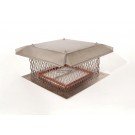What Are Chimney Dampers and Why Do I Need One?

Picture this: you’re home on a cold winter night and you decide to build a roaring fire to keep you and your family warm. After preparing your wood and fostering a strong flame, the house begins to fill with smoke. Panicked, you have the family stay outside while you see to the issue, only to realize that no smoke is coming through your chimney. This is most likely due to a faulty chimney damper. You can think of a chimney damper like a lid for your fireplace. It is located in the flue (the air shaft through which smoke and air can travel in and out of your chimney) above the firebox (where the fire is made) and is in use both when fireplace is active and inactive. We commonly think of chimneys as avenues for smoke to escape from your home, but they are also a way for air to come in. Knowing exactly what your chimney damper is, what it does, and how to control it will ensure better, safer, and more enjoyable fireside chats.
An Inactive Fireplace
Like we said before, when your fireplace isn’t in use, your chimney damper still has a job to do. An open chimney damper will allow air into your home, so if it’s a cold night and you just can’t seem to warm up, make sure that your chimney damper is closed. A closed chimney damper will prevent unwanted air of any temperature from making its way into your home.
An Active Fireplace
When starting a fire in your fireplace, making sure that your chimney damper is open is imperative to a healthy burn. The open chimney damper allows smoke created by your fire to escape through the chimney, whereas a closed chimney damper will force the smoke into the rest of your home. Health risks associated with smoke inhalation are very serious, and you should never have to worry about putting your family in danger when building a fire. An open chimney damper will filter smoke out and keep the air in your home breathable and free of harm.
Sticking to these guidelines and knowing when and how to use your chimney damper will not only ensure a more enjoyable fireside experience, but knowing how it’s supposed to function can tell you if there are any problems with your chimney that need attention. Appreciate and understand all of the parts of your chimney in order to get the most you possibly can out of having one.




